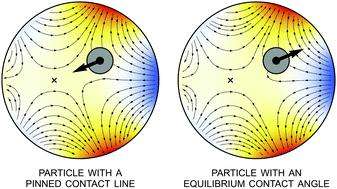当前位置:
X-MOL 学术
›
Soft Matter
›
论文详情
Our official English website, www.x-mol.net, welcomes your feedback! (Note: you will need to create a separate account there.)
Capillary force on an ‘inert’ colloid: a physical analogy to dielectrophoresis
Soft Matter ( IF 3.4 ) Pub Date : 2021-2-16 , DOI: 10.1039/d0sm02143a Joseph M Barakat 1 , Todd M Squires
Soft Matter ( IF 3.4 ) Pub Date : 2021-2-16 , DOI: 10.1039/d0sm02143a Joseph M Barakat 1 , Todd M Squires
Affiliation

|
“Inert” colloids are μm-scale particles that create no distortion when trapped at a planar fluid–fluid interface. When placed in a curved interface, however, such colloids can create interfacial distortions of quadrupolar symmetry – so-called “induced capillary quadrupoles.” The present work explores the analogy between capillary quadrupoles and electric dipoles, and the forces exerted on them by a symmetry-breaking gradient. In doing so, we weigh in on an outstanding debate as to whether a curvature gradient can induce a capillary force on an inert colloid. We argue that this force exists, for the opposite would imply that all dielectrophoretic forces vanish in two dimensions (2D). We justify our claim by solving 2D Laplace problems of electrostatics and capillary statics involving a single particle placed within a large circular shell with an imposed gradient. We show that the static boundary condition on the outer shell must be considered when applying the principle of virtual work to compute the force on the particle, as verified by a direct calculation of this force through integration of the particle stresses. Our investigation highlights some of the subtleties that emerge in virtual work calculations of capillary statics and electrostatics, thereby clarifying and extending previous results in the field. The broader implication of our results is that inert particles – including particles with planar, pinned contact lines and equilibrium contact angles – interact through interparticle capillary forces that scale quadratically with the deviatoric curvature of the host interface, contrary to recent claims made in the literature.
中文翻译:

“惰性”胶体上的毛细管力:介电电泳的物理类比
“惰性”胶体是微米级颗粒,当被困在平面流体-流体界面时不会产生变形。然而,当放置在弯曲界面中时,此类胶体会产生四极对称性的界面扭曲,即所谓的“诱导毛细管四极杆”。目前的工作探讨了毛细管四极子和电偶极子之间的类比,以及对称破缺梯度对它们施加的力。在此过程中,我们参与了关于曲率梯度是否可以在惰性胶体上引起毛细管力的争论。我们认为这种力是存在的,因为反之则意味着所有介电泳力在二维(2D)中消失。我们通过解决静电学和毛细管静电学的二维拉普拉斯问题来证明我们的主张,该问题涉及放置在具有强加梯度的大圆形壳内的单个粒子。我们表明,在应用虚功原理计算粒子上的力时,必须考虑外壳上的静态边界条件,这一点通过通过粒子应力积分直接计算该力来验证。我们的研究强调了毛细管静力学和静电学的虚拟工作计算中出现的一些微妙之处,从而澄清和扩展了该领域以前的结果。我们的结果更广泛的含义是,惰性颗粒(包括具有平面、固定接触线和平衡接触角的颗粒)通过颗粒间毛细管力相互作用,该毛细管力与主体界面的偏曲率呈二次方关系,这与文献中最近提出的主张相反。
更新日期:2021-03-01
中文翻译:

“惰性”胶体上的毛细管力:介电电泳的物理类比
“惰性”胶体是微米级颗粒,当被困在平面流体-流体界面时不会产生变形。然而,当放置在弯曲界面中时,此类胶体会产生四极对称性的界面扭曲,即所谓的“诱导毛细管四极杆”。目前的工作探讨了毛细管四极子和电偶极子之间的类比,以及对称破缺梯度对它们施加的力。在此过程中,我们参与了关于曲率梯度是否可以在惰性胶体上引起毛细管力的争论。我们认为这种力是存在的,因为反之则意味着所有介电泳力在二维(2D)中消失。我们通过解决静电学和毛细管静电学的二维拉普拉斯问题来证明我们的主张,该问题涉及放置在具有强加梯度的大圆形壳内的单个粒子。我们表明,在应用虚功原理计算粒子上的力时,必须考虑外壳上的静态边界条件,这一点通过通过粒子应力积分直接计算该力来验证。我们的研究强调了毛细管静力学和静电学的虚拟工作计算中出现的一些微妙之处,从而澄清和扩展了该领域以前的结果。我们的结果更广泛的含义是,惰性颗粒(包括具有平面、固定接触线和平衡接触角的颗粒)通过颗粒间毛细管力相互作用,该毛细管力与主体界面的偏曲率呈二次方关系,这与文献中最近提出的主张相反。



























 京公网安备 11010802027423号
京公网安备 11010802027423号